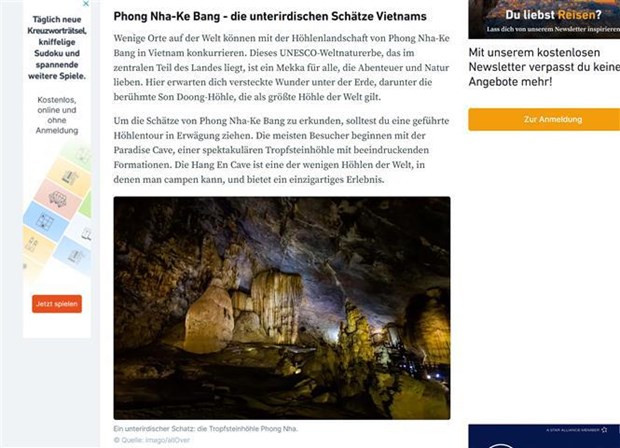The German travel website reisereporter.de has recently published an article introducing hidden treasures and natural wonders often overlooked in Vietnam.
The first place mentioned by the author, Daniel Schramm, in the article is the Phong Nha-Ke Bang cave system, a “treasure beneath the earth” in Quang Binh.
He writes that there are few places in the world that can compare to the cave landscapes of Phong Nha-Ke Bang in Vietnam. This UNESCO World Heritage site is a haven for adventure and nature enthusiasts, with the famous Son Đoong cave being the largest cave in the world. Additionally, the Thien Duong cave boasts a magnificent limestone formation, and the En cave is one of the few caves in the world where camping is allowed.

The idyllic beaches in Con Dao district, Ba Ria-Vung Tau province, are also suggested by the author.
According to him, Con Dao is a true recommendation for travelers seeking a remote paradise island because it boasts some of the most beautiful and pristine beaches in Vietnam. These islands, part of a national park, still retain their original wilderness and serve as a retreat for nature lovers and those seeking tranquility.
One of the most impressive beaches in Con Dao is Dat Doc Beach with its pristine white sand and crystal-clear waters, ideal for swimming and snorkeling. The peaceful atmosphere and low number of tourists make this beach a perfect place to relax and immerse in nature.

Con Dao is a real suggestion for tourists looking for a remote paradise island. Photo: Pham Thanh Tung
Another gem of Con Dao is An Hai, suitable for romantic seaside strolls along the coast and exploring the underwater world of Con Son Bay, where tourists can discover fascinating marine life and diverse coral reefs.
The article also introduces readers to Hoi An, Quang Nam province. The author emphasizes that although Hoi An is not an unfamiliar destination, there are many hidden gems to discover beyond the bustling ancient town.
Hoi An’s ancient town itself is undoubtedly captivating with its ancient architectural structures, but some truly hidden gems lie in less-visited places, such as the Chuc Thanh Pagoda, one of the oldest Buddhist temples in Vietnam.

The author suggests that when visiting Hoi An, travelers should choose to dine at small eateries and restaurants away from the main streets because these small establishments are often frequented by locals and offer authentic Vietnamese flavors.
Furthermore, the article mentions the hidden temples and pagodas in the former imperial capital of Hue in Central Vietnam, known for its impressive citadels and grand tombs.
@Vietnamnet
